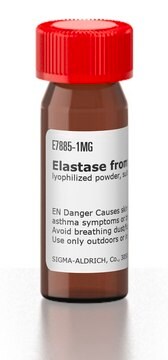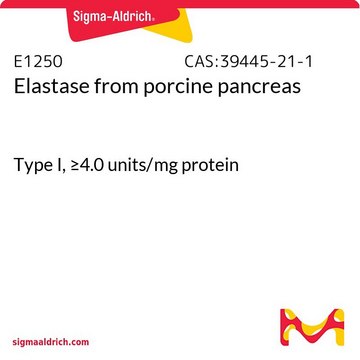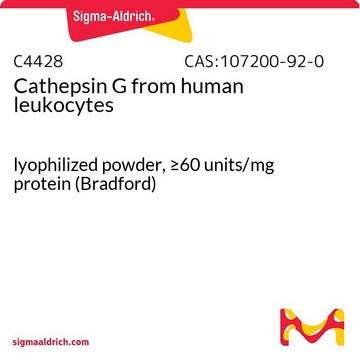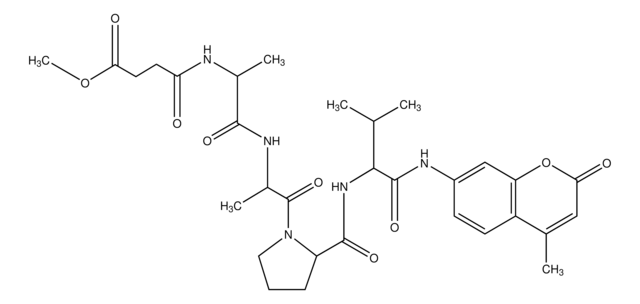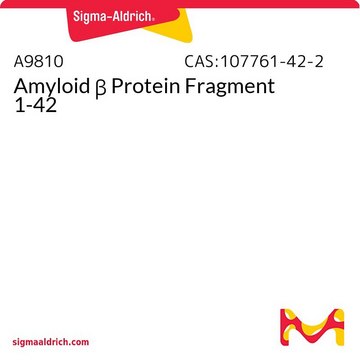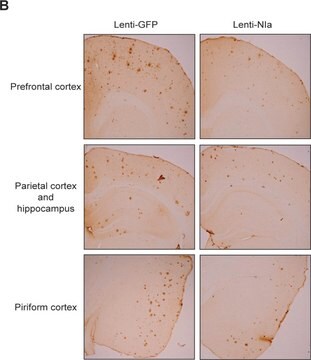E8140
Elastase from human leukocytes
lyophilized powder, ≥50 units/mg protein (Bradford)
Synonym(s):
Lysosomal elastase
Sign Into View Organizational & Contract Pricing
All Photos(1)
About This Item
CAS Number:
MDL number:
UNSPSC Code:
12352204
NACRES:
NA.54
Recommended Products
biological source
human leucocytes
Quality Level
form
lyophilized powder
specific activity
≥50 units/mg protein (Bradford)
mol wt
29 kDa
UniProt accession no.
shipped in
dry ice
storage temp.
−20°C
Gene Information
human ... ELA2(1991) , ELANE(1991)
Looking for similar products? Visit Product Comparison Guide
Related Categories
General description
Elastase is a proteolytic enzyme. It is a member of the subgroup named, peptidyl peptide hydrolases. It is a major anatomic constituent of arteries. It is mainly found in the pancreas and pancreatic juice of various birds and mammals. It is also present in human serum, granulocytes and erythrocytes.
Application
Elastase from human leukocytes has been used:
- to measure serum elastase activity
- in proteolytic digestion of fibronectin and salivary glands
- in neutrophil elastase (NE) activity assay
- cell-free NE digestion of E-cadherin
- scratch wound assay
- in a study that determined that fragments of Nle3-angiotensin(1-7) accelerate healing in dermal models
Biochem/physiol Actions
Elastase enzyme is capable of releasing soluble peptides from insoluble elastin fibers with the help of a proteolytic process. It can stimulate disintegration of the axoneme with the help of adenosine triphosphate (ATP). Unlike pancreatic elastase the leukocyte enzyme has a preferential cleavage for the carboxyl side of valine, but will also cleave to a lesser extent after alanine. Natural substrates include elastin, cartilage proteoglycans, collagen types I, II, II and IV, and fibronectin.
Physical properties
Leukocyte elastase is a 29 kDa serine endoprotease of the Proteinase S1 Family. It exists as a single 238 amino acid-peptide chain with four disulfide bonds. It contains two or thee N-linked glycans of variable composition which account for its three major isoforms.
Isoelectric point: pI = 8.77 - 9.55
Isoelectric point: pI = 8.77 - 9.55
Unit Definition
One unit will release one nanomole of p-nitrophenol per sec from BOC-L-alanine p-nitrophenyl ester at pH 6.5 at 37 °C.
Physical form
Lyophilized from 0.05 M sodium acetate (pH 5.5) and 0.6 M NaCl
Application
Product No.
Description
Pricing
inhibitor
Product No.
Description
Pricing
substrate
Product No.
Description
Pricing
Storage Class Code
13 - Non Combustible Solids
WGK
WGK 1
Flash Point(F)
Not applicable
Flash Point(C)
Not applicable
Choose from one of the most recent versions:
Already Own This Product?
Find documentation for the products that you have recently purchased in the Document Library.
Customers Also Viewed
Koichiro Mihara et al.
The Journal of biological chemistry, 288(46), 32979-32990 (2013-09-21)
Neutrophil proteinases released at sites of inflammation can affect tissue function by either activating or disarming signal transduction mediated by proteinase-activated receptors (PARs). Because PAR1 is expressed at sites where abundant neutrophil infiltration occurs, we hypothesized that neutrophil-derived enzymes might
Carey A Hobbs et al.
American journal of physiology. Lung cellular and molecular physiology, 305(12), L990-L1001 (2013-10-15)
The epithelial sodium channel (ENaC) is responsible for Na(+) and fluid absorption across colon, kidney, and airway epithelia. Short palate lung and nasal epithelial clone 1 (SPLUNC1) is a secreted, innate defense protein and an autocrine inhibitor of ENaC that
III - Hydrolases
Enzymes of the Arterial Wall, 208-390 (1969)
Elastase: General Information1,2
Methods of Enzymatic Analysis, 2, 1041-1045 (1974)
Regulation of Dynein in Ciliary and Flagellar Movement
Dyneins, 366-393 (2012)
Chromatograms
application for HPLCOur team of scientists has experience in all areas of research including Life Science, Material Science, Chemical Synthesis, Chromatography, Analytical and many others.
Contact Technical Service